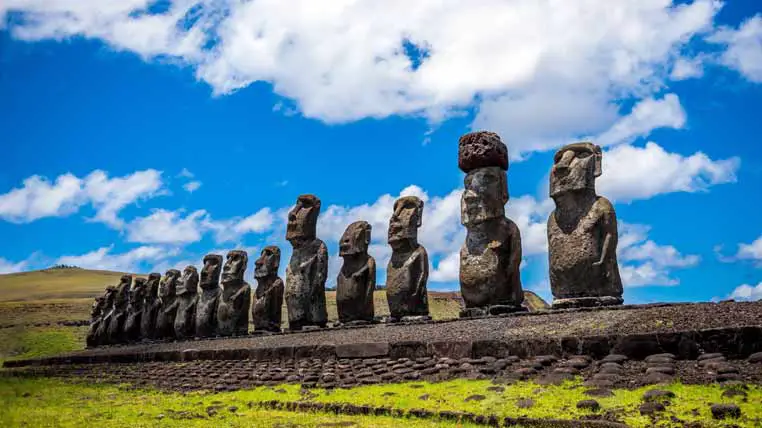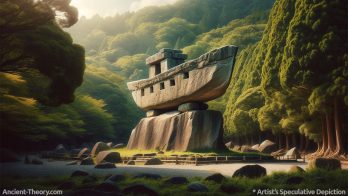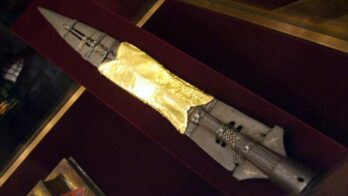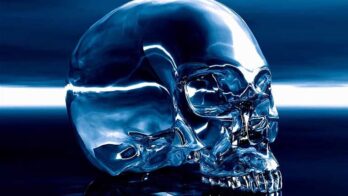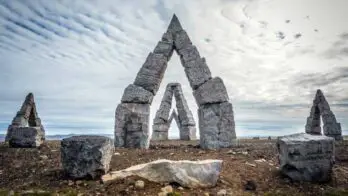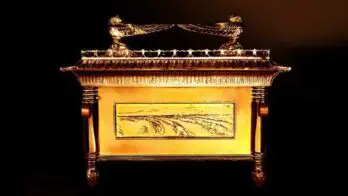Recent evidence suggests that the enigma surrounding the moai statues on Easter Island is strongly related to the true identity of the mysterious “Chief God,” believed to have been responsible for creating these imposing figures.
What Are the Moai Statues?
Moai, or moʻai, which means “statue” in the Rapa Nui language, are monolithic human figures carved by the Rapa Nui people on Easter Island, also known as Rapa Nui, in eastern Polynesia between the years 1250 and 1500.
The production and transportation of over 900 statues are considered extraordinarily creative and physical achievements.
Almost half of them still remain at Rano Raraku, the main quarry, while hundreds were transported and placed on stone platforms called ahu around the island’s perimeter.
The moai statues typically feature large heads, which make up three-eighths of the statue’s overall size, and do not have legs.
They are believed to represent deified ancestors and were considered the living faces (aringa ora) of these ancestors.
When Europeans first visited the island in 1722, the statues were still gazing inland across their clan lands, but by the late 19th century, all of them had fallen.
The moai were toppled in the late 18th and early 19th centuries, possibly due to European contact or internecine tribal wars.
Some of the largest moai ever erected include Paro, which stands almost 10 meters (33 feet) tall and weighs 82 tons, and a shorter but heavier statue at Ahu Tongariki, weighing 95 tons.
Additionally, an unfinished sculpture, if completed, would be approximately 21 meters (69 feet) tall and weigh about 145-165 tons. New statues are still being discovered on the island as of 2023.
Where Are the Moai Statues Located?
Easter Island, one of the most remote places on Earth, covers roughly 65 square miles (about 170 square kilometers) and is located over 1,900 miles (3,000 kilometers) away from the nearest centers of civilization.
On the island’s southeastern coast stand almost 100 megalithic monuments, sculpted to resemble elongated male heads. However, roughly 900 such giant moai statues are scattered throughout the island.
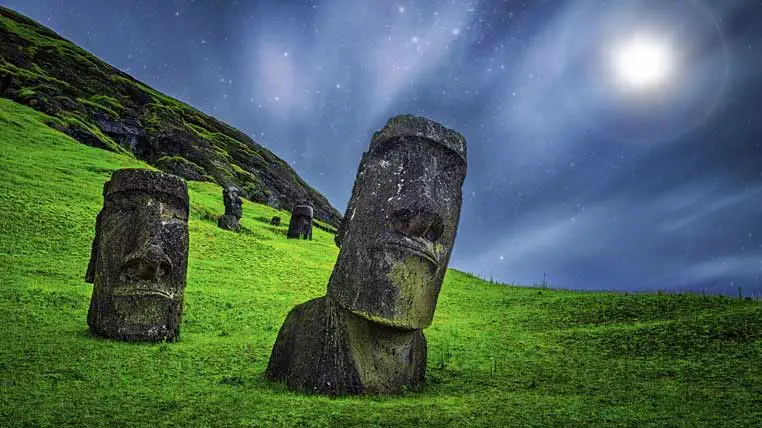
The islanders called their homeland Te Tito O Te Henua, which translates to “the navel of the world,” “the ends of the earth,” or “the end of the lands,” while Europeans named it Easter Island after sighting it on Easter Day in 1722.
When the Dutch sailors of Jacob Roggeveen (1659-1729) first landed on Easter Island, they were astounded to discover the megalithic moai statues. They found hundreds of immense human figures carved in stone and spread across the island.
Even today, the moai statues are considered an incredible creative and physical feat, with the production and transportation of the more than 900 statues being a remarkable accomplishment.
In fact, the question of how Easter Island was initially populated is an enduring mystery.
The nearest continental state is Chile, located to the east, while Tahiti, the closest important island, is 2,500 miles (about 4,000 kilometers) west of Easter Island. The nearest human settlement is Pitcairn Island.
Despite numerous studies, the exact reason for the moai’s construction and the civilization that built them remains a mystery.
Many theories have been proposed, including religious or ceremonial purposes, astronomical observation, or as a way of displaying social status.
The megalithic moai statues were crafted from volcanic rock, which was carved and shaped in a stylized manner. However, the rugged and dense volcanic rock was as tough as iron and required immense effort to shape.
Originally, the statues were adorned with hats, but this detail only deepens the mystery rather than solving it.
Some of these stone hats, weighing over 10 tons each, were discovered far from the moai statues they belonged to. No one knows how they got there and why further complicating the mystery.
A Flourishing Civilization Lost
Easter Island was once home to a flourishing civilization, but by the time Europeans arrived in 1722, the Polynesian population struggled to survive, numbering only a few thousand.
When British navigator James Cook (1728-1779) visited the island fifty years later, the population and soil were even more depleted.
The locals traded their old and elaborate sculptures for clothing and food, but Cook noted in his journals that the statues were not part of the islanders’ sacred rituals, and he referred to them as “monuments of Antiquity.”
As a result, theories that the moai statues of Easter Island were dedicated to fertility and abundance gods seem unfounded.
It is difficult to understand why a community of only a few hundred people would work so hard to cut, transport, and carve nearly a thousand huge stone blocks just to offer them as tribute in exchange for fertile soil.
In fact, many of the secrets of the Rapa Nui civilization, who allegedly created the iconic moai statues, are lost to time. However, it is believed that the society once flourished on the island, with agriculture and fishing being their primary food sources.
In addition to the moai statues, wooden tablets covered in hieroglyphs were discovered near some of the figures.
Sadly, most tablets have disappeared, and only a few remain in museums. The tablets have yet to be deciphered to this day, adding to the mystery of the lost civilization.

Who Was Viracocha, the Creator?
Unfortunately, even on this tiny land, the first missionaries from the West did everything in their power to destroy the culture of the indigenous people.
The apostles burned hundreds of engraved tablets, practically prohibited the practice of ancient cults, and wiped out their traces as much as possible.
However, no matter how hard these pious people tried, they could not prevent the natives from still naming the island “Land of Bird Men.”
According to oral tradition, some flying people landed on the island long ago and taught the inhabitants how to make fire. This legend is confirmed by sculptures depicting flying creatures with large, bulging eyes.
The similarities between Easter Island and Tiahuanaco are apparent. Here and there, we see the same stone giants in the same style, with proud faces and stoic expressions.
When Francisco Pizarro tried to find out from the Incas details about the origin of Tiahuanaco in 1532, they replied that no man had ever seen this city other than in ruins because the era in which it was built was lost in the darkness of time.
The tradition calls Easter Island “the navel of the world.” How can we explain such interferences between two regions located 5,000 km apart? Perhaps pre-Inca mythology will give us some clarifications on this?
Viracocha, the Creator, is among this mythology’s ancient and top-ranking gods.
He is attributed to the creation of the Earth when darkness was everywhere, and the Sun did not exist yet. He first carved a population of giants out of stone.
However, unsatisfied with his work, he unleashed a massive wave of water over it, drowning the planet.
Then, he raised the Sun and the Moon above Lake Titicaca to bring light to the Earth. Finally, Viracocha molded human and animal figures out of clay at Tiahuanaco and gave them life.
Does this sound familiar?
Viracocha also gave humans language, taught them how to grow crops, use metals, and record history, and provided them with some powerful tools to do all that.
Eventually, he sent some of them flying to populate other continents.
Wishing to see if his advice had been followed to the letter and what the results were, he then undertook a journey accompanied by two assistants.
In the guise of an old man, Viracocha crossed the Andes and traveled a long way along the coastlines. Here and there, he was received with hostility.
The people of Cacha were so unwelcoming that, overcome by righteous anger, he set fire to a rock, and the blaze threatened to engulf the entire region.
The ungrateful people begged for his forgiveness, and he put out the fire with a simple sign of his hand.
During his travels, Viracocha continued to give advice here and there, and many temples were erected in his honor.
Finally, in the coastal province of Manta, he bade farewell to the mortals, promising to come back someday. He stepped over the waves and disappeared into the distance.
Everywhere the conquistadors went in Central and South America, they heard about Viracocha and his “white giants,” who were said to have descended from the heavens.
Amazed, they learned that these giants belonged to a lineage created by the Sons of the Sun, who had taught people all sorts of crafts before vanishing without a trace.
All the legends the Spaniards had heard asserted that the Sons of the Sun would return.
In fact, the American continent is the cradle of some of the oldest civilizations. However, our knowledge of these civilizations only extends about a millennium.
The Emperor-God Ariki
Will we ever know why, 3,000 years before our era, the Incas in Peru were cultivating cotton, although they did not know the art of weaving? Or will we ever find out why the Mayas, who knew the wheel but did not use it, built roads?
According to the stories told to the first European missionaries, until 1780, Easter Island had been ruled by an Emperor-God named Ariki.
He had absolute power over the population, supported by his role in the cult of the god Tangata Manu, which translates to “The Bird-Man.” Ariki was the one who commanded the construction of these moai.
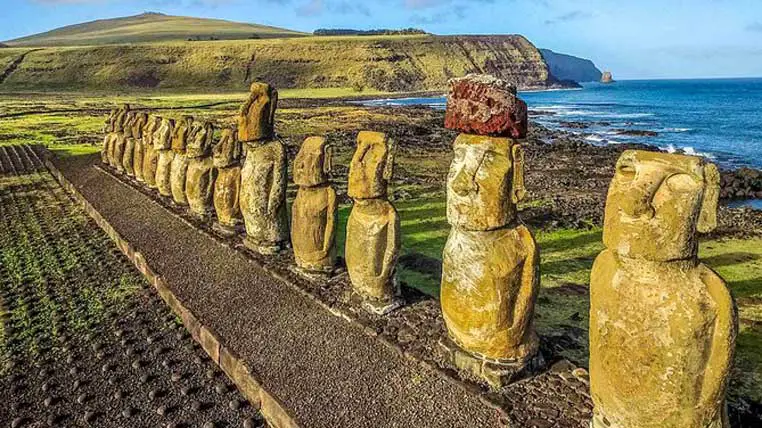
Local legends suggest that the long ears depicted in the moai sculptures were not an artistic exaggeration but a faithful representation of Ariki’s and his family members’ ears, intentionally elongated by wearing weights in childhood.
But how is it possible that Ariki ordered the carving of almost a thousand such giant statues when radiocarbon dating unequivocally shows that some sculptures were made in the early 400s and others date back to around 1200-1300?
Ancient Architects
The mystery surrounding the megalithic statues of Easter Island is not unique.
Another enigma is the origin of the jade used in sculpting the objects found throughout Guatemala.
For instance, archaeologists are still fascinated by an extraordinary green jade necklace, woven from five strands, found in the pyramid at Tikal in Guatemala.
Who can explain the presence of jade, a semi-precious stone primarily found in China, in the depths of an ancient Guatemalan temple?
The closest known deposits of jade are in Alaska and Canada, thousands of kilometers from Guatemala. Nevertheless, even this cannot explain the origin of the jade used by the Mayans since the composition of Chinese jade is unique, being more translucent.
And what about the Olmecs’ sculptures with their giant heads covered with helmets?
Only the smallest of these monoliths, weighing not more than 50 tons, could be moved with the help of cranes and special modern machinery. Our technology is powerless when it comes to monoliths weighing over 100 tons.
Yet, our distant ancestors were able to move these massive stone masses through mountains and valleys. How did they do it?
The Egyptians brought their obelisks from Aswan, the architects at Stonehenge carried the stone blocks from South West Wales and Marlborough, and the sculptors of the megalithic statues on Easter Island moved their stone monsters from quarries far from the coast.
As for the monoliths at Tiahuanaco, nobody even knows where some of them came from.
Possible Clues in the Unusual Placement of Ancient Monuments?
Ancient civilizations often built temples and placed sculptures in seemingly impossible locations, leading to perplexing questions about their motives.
Were these challenges undertaken to complicate their existence, or was it for some more profound and meaningful purpose?
It would be a disservice to consider the ancient artists behind these structures foolish, as they could have easily built their temples and statues closer to the quarries.
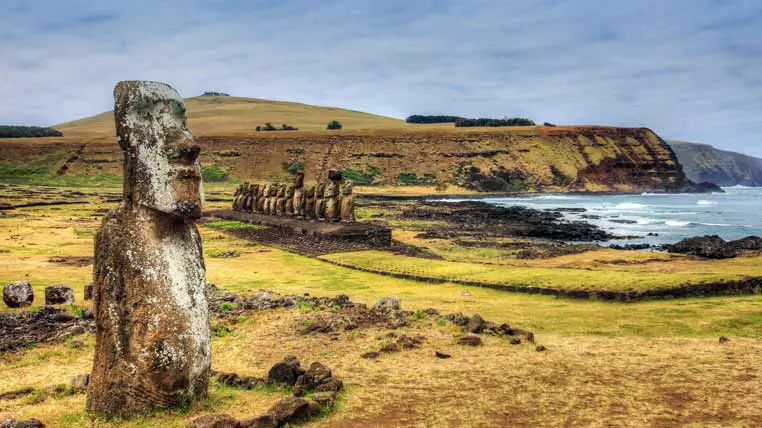
Instead, they adhered to tradition and chose specific locations over others. The Incan fortress of Sacsayhuaman is a prime example of such intentional placement.
Moreover, it is widely believed that the most significant vestiges of ancient civilizations can be found beneath the soil surrounding these monumental structures, offering invaluable insights into our past.
The Bizarre Arrangement of the Megalithic Moai Statues
The megalithic statues of Easter Island are known for their unusual placement, with their backs facing the ocean. Archaeologists believe this was a deliberate decision, marking the edge of the Polynesian world.
The megaliths are believed to represent the spirits of ancestors and great chiefs, with their standardized faces possibly serving as an archetype of a strong individual.
Anthropologist Jo Anne Van Tilburg has suggested that the statues were placed on stone platforms to act as bridges between the heavenly gods and the earth.
The Polynesians believed that the statues were “props of the sky,” helping to support the heavens, while their chiefs were considered pillars of support for the community.
Initially thought to have been built between 1400 and 1550, the megalithic monuments on Easter Island were later discovered to be much older, with radiocarbon dating placing their construction around 700 years earlier.
The area’s history can be traced back to the arrival of the Polynesians in 400 AD. The Easter Island community experienced a decline around 1550, with resources becoming scarce following the arrival of Europeans.
Theories and Speculations about the Transport of the Easter Island Megaliths
The ability to move the Moai statues from the quarry to their final locations remains a mystery, especially since there is no evidence of the use of pulley systems or wheels to assist in the transportation of the massive stone blocks.
Thor Heyerdahl researched these mysterious giants and discovered that three distinct civilizations had succeeded each other on the island, with the first civilization being the most advanced.
Heyerdahl found charred pieces of wood dating back to 400 AD, but nothing proves that the coal and bone remains have any connection to the giant stones.
Hundreds of unfinished statues were found by Heyerdahl along the island’s rocky walls and around the volcanic craters. Thousands of tools, mere stone axes, were scattered everywhere, as if the work had been suddenly interrupted.
There is not a single tree on the island’s volcanic soil, making it impossible to explain how the giants were transported using wood. In fact, Easter Island could not sustain more than 2,000 people, and today there are only a few hundred left.
Given the distance to the nearest inhabited land, it is unlikely that the island was supplied by the sea with food and clothing in the distant past.
Who could have detached such blocks of stone directly from the mountain, then processed and transported them without the help of any sort of wood-made transportation system?
Who gave them the final shape, polished them, and raised them on their feet? And how were these 10-ton hats placed on their heads, whose stone came from a different quarry than the statues?
While some scientists try to convince us that the pyramids in Egypt were built with the help of tens of thousands of people, the same reasoning cannot be applied to the Moai statues on Easter Island, where such a mass of people did not exist.
In any case, 2,000 people could not have chiseled these giants from volcanic stone as hard as steel with their primitive tools, not even if they had worked day and night.
Moreover, some of the inhabitants had to cultivate the poor lands of the island, take care of fishing, and weave fabrics and ropes, leaving little time for creating such monumental structures.
It is clear that 2,000 people could not have raised the colossus statues, and a larger population could not have sustained itself on the island.
Under these conditions, it remains to be seen who created these sculptures, for what purpose, and why all the statues are raised around the shorelines and none inside the island. To which cult did they serve?
The bizarre positioning of the statues and the unique nature of their placement led Professor Charlie Love from Western Wyoming Community College to study the giant structures.
In 2000, Love and his team of archaeologists, students, and locals spent several months on the island investigating how the massive stone statues, some weighing over 90 tons, were moved from the quarry to the coastal ceremonial centers.
Despite months of research, Love and his team could not unravel the mysteries of Easter Island moai statues. Theories and speculations about the transport of the megaliths abound.
One popular but baseless theory suggests that the Lemurians, a highly advanced race of people, used ancient secrets involving levitation and the secret of stone liquefaction to carve, move, and raise the monuments.
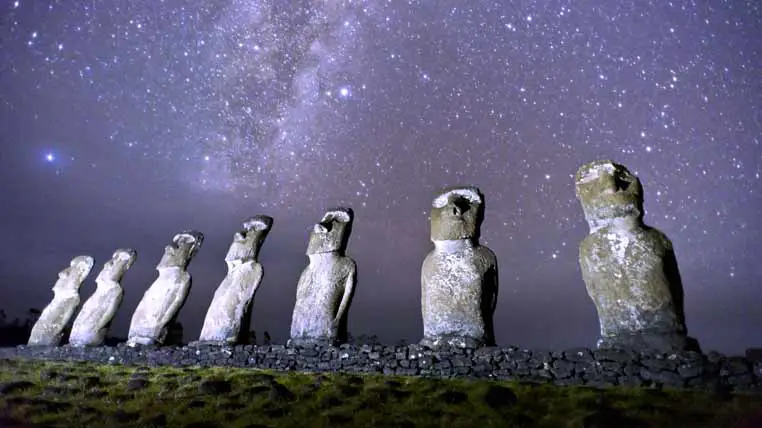
Other theories with more scientific basis suggest that the island was initially populated by navigators traveling between South America and Polynesia.
These settlers would have established a thriving community on Easter Island and raised the monuments, although the reasons for doing so remain unclear.
Anthropologist Thor Heyerdahl proposed the east-west theory in 1948, asserting that the prehistoric inhabitants of South America could have navigated the ocean to the central-western Pacific islands.
To demonstrate the feasibility of this theory, Heyerdahl undertook a daring journey across the Pacific in a primitive wooden balsa raft called Kon Tiki.
The voyage covered 7,000 km in 101 days, demonstrating that such a journey could have been accomplished since the region benefits from favorable winds blowing east to west, making the journey less challenging.
Van Tilburg’s Theory
Dr. Jo Anne Van Tilburg is an archaeologist and the director of the Easter Island Statue Project, which focuses on studying and conservating the moai statues on Easter Island.
Van Tilburg’s work has contributed significantly to our understanding of the history and significance of these iconic statues.
Van Tilburg’s research on the moai statues on Easter Island has focused on understanding how they were made, transported, and erected. She has also explored these statues’ cultural and religious significance to the people who created them.
One of Van Tilburg’s most significant contributions to the field of Easter Island archaeology is her theory regarding the process by which the moai statues were moved from the quarries where they were carved to their final positions on ceremonial platforms called ahu.
According to Van Tilburg, the statues were not “walked” to their positions, as was previously believed, but were instead transported on tracks using a system of ropes, rollers, and pivots.
Van Tilburg’s theory was based on her analysis of the moai statues and ethnographic and historical evidence from other cultures that have used similar techniques to move large stone objects.
Her work has helped dispel many myths and misconceptions surrounding the moai statues for centuries and shed new light on the ingenuity and technological sophistication of the people who created them.
At Ancient Theory we only use trusted sources to document our articles. Such relevant sources include authentic documents, newspaper and magazine articles, established authors, or reputable websites.
- Sarah Pruit - How Easter Island's Mysterious Statues Got Their 12-Ton Hats. history.com.
- Easter Island statues: mystery behind their location revealed. The Guardian. [Source]
- Emily Dixon - One mystery of Easter Island's statues finally solved, researchers say. edition.cnn.com.
- Whitney Dangerfield - The Mystery of Easter Island. [Source]
- Jessica Wolf - The mystery of Easter Island revealed? [Source]
- Steven R. Fischer - The island at the end of the world. Reaktion Books, 2005.
- Carl P. Lipo, Terry L. Hunt and Sergio Rapu Haoa - The Walking Megalithic Statues (Moai) of Easter Island. Journal of Archaeological Science, 2013. [Source]
- Sarah C. Sherwood, Jo Anne Van Tilburg, Casey R. Barrier, Mark Horrocks, Richard K. Dunn and José Miguel Ramírez-Aliaga - New excavations in Easter Island's statue quarry: Soil fertility, site formation, and chronology. Journal of Archaeological Science, 2019. [Source]
